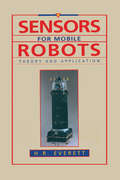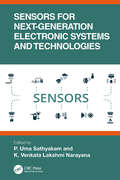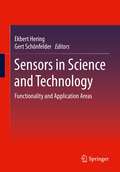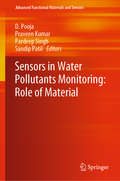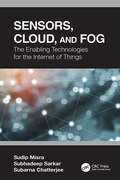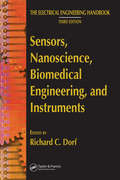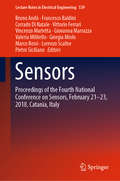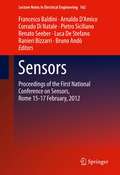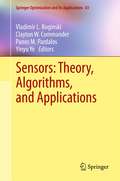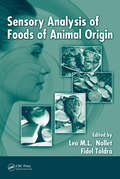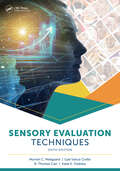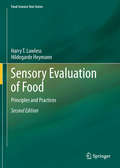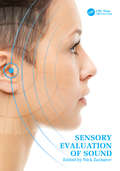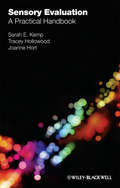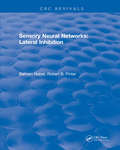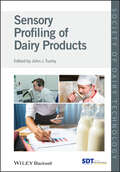- Table View
- List View
Sensors for Mobile Robots
by H.R. EverettThe author compiles everything a student or experienced developmental engineer needs to know about the supporting technologies associated with the rapidly evolving field of robotics.From the table of contents: Design Considerations * Dead Reckoning * Odometry Sensors * Doppler and Inertial Navigation * Typical Mobility Configurations * Tactile and
Sensors for Next-Generation Electronic Systems and Technologies
by P. Uma Sathyakam K. Venkata Lakshmi NarayanaThe text covers fiber optic sensors for biosensing and photo-detection, graphene and CNT-based sensors for glucose, cholesterol, and dopamine detection, and implantable sensors for detecting physiological, bio-electrical, biochemical, and metabolic changes in a comprehensive manner. It further presents a chapter on sensors for military and aerospace applications. It will be useful for senior undergraduate, graduate students, and academic researchers in the fields of electrical engineering, electronics, and communication engineering.The book Discusses implantable sensors for detecting physiological, bio-electrical, biochemical, and metabolic changes Covers applications of sensors in diverse fields including healthcare, industrial flow, consumer electronics, and military Includes experimental studies such as the detection of biomolecules using SPR sensors and electrochemical sensors for biomolecule detection Presents artificial neural networks (ANN) based industrial flow sensor modeling Highlights case studies on surface plasmon resonance sensors, MEMS-based fluidic sensors, and MEMS-based electrochemical gas sensors The text presents case studies on surface plasmon resonance sensors, MEMS-based fluidic sensors, and MEMS-based electrochemical gas sensors in a single volume. The text will be useful for senior undergraduate, graduate students, and academic researchers in the fields of electrical engineering, electronics, and communication engineering.
Sensors for Safety and Process Control in Hydrogen Technologies (Series in Sensors)
by Thomas Hübert Lois Boon-Brett William ButtnerUnderstand, Select, and Design Sensors for Hydrogen-Based ApplicationsThe use of hydrogen generated from renewable energy sources is expected to become an essential component of a low-carbon, environmentally friendly energy supply, spurring the worldwide development of hydrogen technologies. Sensors for Safety and Process Control in Hydrogen Technologies provides practical, expert-driven information on modern sensors for hydrogen and other gases as well as physical parameters essential for safety and process control in hydrogen technologies. It illustrates how sensing technologies can ensure the safe and efficient implementation of the emerging global hydrogen market.The book explains the various facets of sensor technologies, including practical aspects relevant in hydrogen technologies. It presents a comprehensive and up-to-date account of the theory (physical and chemical principles), design, and implementations of sensors in hydrogen technologies. The authors also offer guidance on the development of new sensors based on the analysis of the capabilities and limitations of existing sensors with respect to current performance requirements.Suitable for both technical and non-technical personnel, the book provides a balance between detailed descriptions and simple explanations. It gives invaluable insight into the role sensors play as key enabling devices for both control and safety in established and emerging hydrogen technologies.
Sensors for Stretchable Electronics in Nanotechnology (Emerging Materials and Technologies)
by Kaushik PalSensors for Stretchable Electronics in Nanotechnology discusses the fabrication of semiconducting materials, simple and cost-effective synthesis, and unique mechanisms that enable the fabrication of fully elastic electronic devices that can tolerate high strain. It reviews specific applications that directly benefit from highly compliant electronics, including transistors, photonic devices, and sensors. Discusses ultra-flexible electronics, highlighting its upcoming significance for the industrial-scale production of electronic goods Outlines the role of nanomaterials in fabricating flexible and multifunctional sensors and their applications in sensor technologies Covers graphene-based flexible and stretchable strain sensors Details various applications including wearable electronics, chemical sensors for detecting humidity, environmental hazards, pathogens, and biological warfare agents, and biosensors for detecting vital signals This book is a valuable resource for students, scientists, and professionals working in the research areas of sensor technologies, nanotechnology, materials science, chemistry, physics, biological and medical sciences, the healthcare industry, environmental science, and technology.
Sensors in Science and Technology: Functionality and Application Areas
by Ekbert Hering Gert SchönfelderSensors are used to measure physical, chemical and biological quantities. The book offers a comprehensive overview of physical principles, functions and applications of sensors. It is structured according to the fields of activity of sensors and shows their application by means of typical examples. Measured variables that can be recorded by sensors are e.g. mechanical, dynamic, thermal, electrical and magnetic. Furthermore, optical and acoustical sensors are discussed in detail in the book. The sensor signals are recorded, processed and converted into control signals for actuators. Such sensor systems are also presented.
Sensors in Water Pollutants Monitoring: Role of Material (Advanced Functional Materials and Sensors)
by D. Pooja Praveen Kumar Pardeep Singh Sandip PatilThis book discusses the sensitivity, selectivity, and response times of different sensor materials and their potential application in the design of portable sensor systems for monitoring water pollutants and remediation systems. Beginning with an overview on water pollutants and analytical methods for their detection, the book then moves on to describing the advances in sensor materials research, and the scope for their use in different types of sensors. The book lays emphasis on techniques such as colorimetric, fluorescence, electrochemical, and biological sensing of conventional and emerging pollutants. This book will serve as a handy guide for students, researchers, and professional engineers working in the field of sensor systems for monitoring water pollutants to address various challenges.
Sensors, Cloud, and Fog: The Enabling Technologies for the Internet of Things
by Sudip Misra Subhadeep Sarkar Subarna ChatterjeeThis book provides an in-depth understanding of Internet of Things (IoT) technology. It highlights several of today's research and technological challenges of translating the concept of the IoT into a practical, technologically feasible, and business-viable solution. It introduces two novel technologies--sensor-cloud and fog computing--as the crucial enablers for the sensing and compute backbone of the IoT. The book discusses these two key enabling technologies of IoT that include a wide range of practical design issues and the futuristic possibilities and directions involving sensor networks and cloud and fog computing environments towards the realization and support of IoT. Classroom presentations and solutions to end of chapter questions are available to instructors who use the book in their classes.
Sensors, Instrumentation and Special Topics, Volume 6: Proceedings of the 29th IMAC, A Conference on Structural Dynamics, 2011
by Tom ProulxSensors, Instrumentation and Special Topics, Volume 6. Proceedings of the 29th IMAC, A Conference and Exposition on Structural Dynamics, 2011, the sixth volume of six from the Conference, brings together 27 contributions to this important area of research and engineering. The collection presents early findings and case studies on fundamental and applied aspects of Structural Dynamics, including papers on Structural Health Monitoring, High Intensity Noise Generation and other Special Topics.
Sensors, Nanoscience, Biomedical Engineering, and Instruments: Sensors Nanoscience Biomedical Engineering (The Electrical Engineering Handbook)
by Richard C. DorfIn two editions spanning more than a decade, The Electrical Engineering Handbook stands as the definitive reference to the multidisciplinary field of electrical engineering. Our knowledge continues to grow, and so does the Handbook. For the third edition, it has expanded into a set of six books carefully focused on a specialized area or field of study. Each book represents a concise yet definitive collection of key concepts, models, and equations in its respective domain, thoughtfully gathered for convenient access.Sensors, Nanoscience, Biomedical Engineering, and Instruments provides thorough coverage of sensors, materials and nanoscience, instruments and measurements, and biomedical systems and devices, including all of the basic information required to thoroughly understand each area. It explores the emerging fields of sensors, nanotechnologies, and biological effects. Each article includes defining terms, references, and sources of further information. Encompassing the work of the world’s foremost experts in their respective specialties, Sensors, Nanoscience, Biomedical Engineering, and Instruments features the latest developments, the broadest scope of coverage, and new material on multisensor data fusion and MEMS and NEMS.
Sensors: Proceedings Of The Second National Conference On Sensors, Rome 19-21 February 2014 (Lecture Notes in Electrical Engineering #319)
by Marco Rossi Corrado Di Natale Pietro Siciliano Vittorio Ferrari Bruno Andò Vincenzo Marletta Francesco Baldini Giovanna Marrazza Valeria Militello Giorgia Miolo Lorenzo ScaliseThis book contains a selection of papers presented at the Second National Conference on Sensors held in Rome 19-21 February 2014. The conference highlighted state-of-the-art results from both theoretical and applied research in the field of sensors and related technologies. This book presents material in an interdisciplinary approach, covering many aspects of the disciplines related to sensors, including physics, chemistry, materials science, biology and applications.
Sensors: Proceedings of the First National Conference on Sensors, Rome 15-17 February, 2012
by Corrado Di Natale Arnaldo D’amico Renato Seeber Pietro Siciliano Bruno Andò Francesco Baldini Luca De Stefano Ranieri BizzarriThis book contains a selection of papers presented at the First National Conference on Sensors held in Rome 15-17 February 2011. The conference highlighted state-of-the-art results from both theoretical and applied research in the field of sensors and related technologies. This book presents material in an interdisciplinary approach, covering many aspects of the disciplines related to sensors, including physics, chemistry, materials science, biology and applications. · Provides a selection of the best papers from the First Italian National Conference on Sensors; · Covers a broad range of topics relating to sensors and microsystems, including physics, chemistry, materials science, biology and applications; · Offers interdisciplinary coverage, aimed at defining a common ground for sensors beyond the specific differences among the different particular implementation of sensors.
Sensors: Theory, Algorithms, and Applications (Springer Optimization and Its Applications #61)
by Panos M. Pardalos Vladimir L. Boginski Yinyu Ye Clayton W. CommanderThe objective of this book is to advance the current knowledge of sensor research particularly highlighting recent advances, current work, and future needs. The goal is to share current technologies and steer future efforts in directions that will benefit the majority of researchers and practitioners working in this broad field of study.
Sensory Analysis of Foods of Animal Origin
by Fidel Toldrá Leo M.L. NolletWhen it comes to food selection, consumers are very reliant on their senses. No matter the date on a carton of milk or the seal on the package of meat, how that milk smells and the color of that meat are just as critical as any official factors. And when it comes to meal time, all the senses must conspire to agree that taste, smell, color, and text
Sensory Biology of Plants
by Sudhir SoporyPlants provide a source of survival for all life on this planet. They are able to capture solar energy and convert it into food, feed, wood and medicines. Though sessile in nature, over many millions of years, plants have diversified and evolved from lower to higher life forms, spreading from sea level to mountains, and adapting to different ecozones. They have learnt to cope with challenging environmental conditions and various abiotic and biotic factors. Plants have also developed systems for monitoring the changing environment and efficiently utilizing resources for growth, flowering and reproduction, as well as mechanisms to counter the impact of pests and diseases and to communicate with other biological systems, like microbes and insects. This book discusses the “awareness” of plants and their ability to gather information through the perception of environmental cues, such as light, gravity, water, nutrients, touch and sound, and stresses. It also explores plants’ biochemical and molecular “computing” of the information to adjust their physiology and development to the advantage of the species. Further, it examines how plants communicate between their different organs and with other organisms, as well as the concepts of plant cognition, experience and memory, from both scientific and philosophical perspectives. Lastly, it addresses the phenomenon of death in plants.The epilogue presents an artist’s view of the beauty of the natural world, especially plant “architecture”. The book provides historical perspectives, comparisons with animal systems where needed, and general biochemical and molecular concepts and themes. Each chapter is selfcontained, but also includes cross talk with other chapters to offer an integrated view of plant life and allow readers to appreciate and admire the functioning of plant life from within and without. The book is a tribute by the Editor to his students, colleagues and co-workers and to those in whose labs he has worked.
Sensory Discrimination Tests and Measurements
by Jian BiSensory testing and measurement are the main functions of sensory analysis. In recent years, the sensory and consumer field has evolved to include both difference testing and similarity testing, and new sensory discrimination methods such as the tetrads have received more attention in the literature. This second edition of Sensory Discrimination Tests and Measurements is updated throughout and responds to these changes and includes: A wide range of sensory measurements: Measurements of sensory effect (d', R-index and Gini-index); Measurements of performance of trained sensory panel (Intraclass correlation coefficients and Cronbach?s coefficient alpha); Measurements of relative importance of correlated sensory and consumer attributes (drivers of consumer liking or purchase intent); Measurements of consumer emotions and psychographics; Measurements of time-intensity; Measurements of sensory thresholds; Measurements of sensory risk with negative sensory effects (Benchmark Dose, BMD, methodology) Measurements of sensory shelf life (SSL). A balanced introduction of sensory discrimination tests including difference tests and similarity tests. Bayesian approach to sensory discrimination tests. Modified and multiple-sample discrimination tests. Replicated discrimination tests using the beta-binomial (BB), corrected beta-binomial (CBB), and Dirichlet-multinomial (DM) models. Sensory discrimination methods including the tetrads and the ?M+N?. R and S-Plus codes for all the measurements and tests introduced in the book. Mainly intended for researchers and practitioners in the sensory and consumer field, the book is a useful reference for modern sensory analysis and consumer research, especially for sensometrics.
Sensory Evaluation Techniques
by Gail Vance Civille B. Thomas CarrThis new edition of a bestseller covers all phases of performing sensory evaluation studies, from listing the steps involved in a sensory evaluation project to presenting advanced statistical methods. Like its predecessors, Sensory Evaluation Techniques, Fifth Edition gives a clear and concise presentation of practical solutions, accepted methods,
Sensory Evaluation Techniques
by Gail Vance Civille B. Thomas Carr Katie E. OsdobaThe sixth edition of this classic text brings sensory evaluation to life for new students and experienced professionals alike. A full array of sensory methods is covered – including descriptive techniques, discrimination testing, and consumer research, plus guidance on test design, statistical analysis, and how to translate results into insights for actionable decisions. Like its predecessors, Sensory Evaluation Techniques, Sixth Edition gives a clear and concise presentation of practical solutions, accepted methods, and standard practices, in addition to advanced techniques.What’s new in the sixth edition: An expanded chapter on Sensory Physiology, including recent research on individual differences in perception A thorough discussion of Thurstonian theory and its application to discrimination methods, including the Tetrad Test New sections on technology in sensory evaluation, including a discussion of software options for data collection Improved & updated case studies to aid learning comprehension Updated appendices for Spectrum Method attributes, references, and scales Updated references Online supplemental content Sensory Evaluation Techniques remains a practical, relevant, and flexible resource, providing how-to information for a wide variety of users in industry, government, and academia who need the most current information to conduct effective sensory research. It also supplies students with the necessary theoretical background in sensory evaluation methods, applications, and interpretations.
Sensory Evaluation Techniques: Volume 2 (Routledge Revivals #2)
by Morten MeilgaardFirst Published in 1987, this book offers a full insight into the methods of evaluating the sensory capabilities in certain individuals. Carefully compiled and filled with a vast repertoire of notes, diagrams, and references this book serves as a useful reference for students of medicine and other practitioners in their respective fields.
Sensory Evaluation of Food
by Hildegarde Heymann Harry T. LawlessThis volume covers all the basic techniques of sensory testing, from simple discrimination tests to home use placements for consumers. It provides fundamental theories, psychological and statistical, that form the basis and rationale for sensory test design. Statistics used in sensory evaluation are also demonstrated both as stand-alone material presented in appendices and as integrated applications in the context of appropriate sensory methods. Chapters are constructed so that beginning students who want only the practical aspects of conducting sensory test will see clear instruction on how test should be conducted. Advanced students and practitioners will enjoy the more detailed sections on rationale and related issues.
Sensory Evaluation of Food: Statistical Methods and Procedures (Food Science And Technology Ser. #16)
by Michael O'MahonySensory Evaluation of Food: Statistical Methods and Procedure covers all of the basic techniques of sensory testing, from simple discrimination tests to home use placements for consumers. Providing a practical guide to how tests are conducted, the book explores the fundamental psychological and statistical theories that form the basis and rationale for sensory test design. It also demonstrates how statistics used in sensory evaluation can be applied in integrated applications in the context of appropriate sensory methods, as well as in stand-alone material in appendices. Offering a balanced view of diverse approaches, this is an essential guide for industry professionals and students.
Sensory Evaluation of Sound
by Nick ZacharovSensory Evaluation of Sound provides a detailed review of the latest sensory evaluation techniques, specifically applied to the evaluation of sound and audio. This three-part book commences with an introduction to the fundamental role of sound and hearing, which is followed by an overview of sensory evaluation methods and associated univariate and multivariate statistical analysis techniques. The final part of the book provides several chapters with concrete real-world applications of sensory evaluation ranging from telecommunications, hearing aids design and binaural sound, via the latest research in concert hall acoustics through to audio-visual interaction. Aimed at the engineer, researcher, university student or manager the book gives insight into the advanced methods for the sensory evaluation with many application examples. Introduces the fundamental of hearing and the value of sound Provides a firm theoretical basis for advanced techniques in sensory evaluation of sound that are then illustrated with concrete examples from university research through to industrial product development Includes chapters on sensory evaluation practices and methods as well as univariate and multivariate statistical analysis Six application chapters covering a wide range of concrete sensory evaluation study examples including insight into audio-visual assessment Includes data analysis with several associated downloadable datasets Provides extensive references to the existing research literature, text books and standards
Sensory Evaluation: A Practical Handbook
by Tracey Hollowood Joanne Hort Sarah E. KempThis book is a practical guide to sensory evaluation methods and techniques in the food, cosmetic and household product industries. It explains the suitability of different testing methods for different situations and offers step-by-step instructions on how to perform the various types of tests. Covering a broad range of food and non-food product applications, the book is designed to be used as a practical reference in the testing environment; a training manual for new recruits into sensory science, and a course book for students undertaking industrial training or academic study.
Sensory Neural Networks: Lateral Inhibition (CRC Press Revivals)
by Bahram Nabet Robert B PinterSensory information is detected and transformed by sensory neural networks before reaching higher levels of processing. These networks need to perform significant processing tasks while being compatible with the following levels. Lateral inhibition is a mechanism of local neuronal interaction that produces significant global properties. This book discusses those sensory neural networks influenced by nonlinear lateral inhibition. It features biological bases of lateral inhibition models, computational properties of these models that stress their short term adaptive behavior, their relation to recent activity in neural networks and connectionist systems, their use for image processing applications, and their application to motion detection. Descriptions from different technologies of analog hardware implementations of these classes of networks are described and results from implementations that corroborate theoretical analysis and show technologically desirable applications are presented. The book also uses nonlinear mathematical techniques to analyze temporal and spatial behavior of models presented within the text. Sensory Neural Networks: Lateral Inhibition is an interdisciplinary work that will prove useful to neural network theorists, biologists, circuit designers, and vision scientists.
Sensory Profiling of Dairy Products (Society of Dairy Technology)
by John J. TuohySensory Profiling of Dairy Products In Sensory Profiling of Dairy Products, distinguished dairy technologist Dr John J. Tuohy delivers an expert discussion of advances in the sensory profiling of dairy products, including the physiology of sensory perception, sensory profiling methodology, statistical data analysis and consumer studies. The book covers the sensory profiling of dairy products like fluid milk, yoghurt, a wide range of internationally popular cheese varieties, ice cream, butter, and milkfat products. Beginning with a historical review of the sensory evaluation of dairy products, the book covers recent advances in the practice. The editor has also included resources that profile the sensory attributes of the products most important to the dairy industry: fluid milks, cream and milkfat products, frozen dairy desserts, and a variety of cheeses. Readers will also find: A thorough introduction to sensory analysis and consumer mindsets and emotions regarding dairy products Comprehensive explorations of the chemistry, biochemistry and physiology of sensory perception of the flavour and mouthfeel stimuli imparted by dairy products Practical discussions of the sensory attributes of fat-rich dairy and ethnic Indian products Fulsome treatments of the sensory profiles of natural and processed cheese varieties Perfect for dairy professionals, regulators, and lawmakers, Sensory Profiling of Dairy Products will also earn a place in the libraries of food marketing professionals, retailers, and culinary practitioners, as well as professors and students with an interest in dairy products. For information regarding the Society of Dairy Technology please visit www.sdt.org
Sensory Science and Chronic Diseases: Clinical Implications and Disease Management
by Paule Valery Joseph Valerie Buzas DuffyThe textbook provides an overview of the sensory science field in the context of diseases such as obesity and Coronavirus disease 2019 (COVID-19). This book brings a summary of the state of the science in key areas and provides examples of translational science from using cellular and rodent models to human clinical trials and community health. The volume structure leads the reader through the physiology of taste and smell into how sensory testing for taste and smell is studied, basic mechanisms, various protocols that are used throughout the field along with the pros/cons of the current methods used. This resource is intended for classroom teaching, for novice researchers in sensory research as well as students and postdoctoral fellows. Example of courses are nutrition, basic nursing, interdisciplinary health courses, sensory perception (psychology), neuroscience, and medical courses, dentistry, food science and others.
